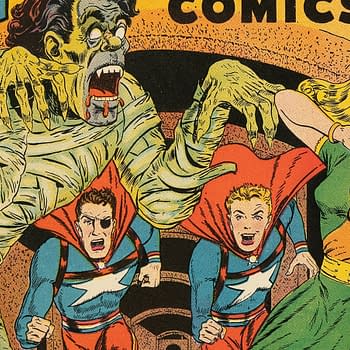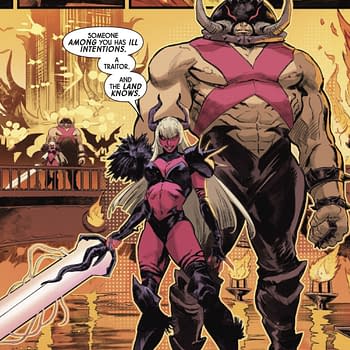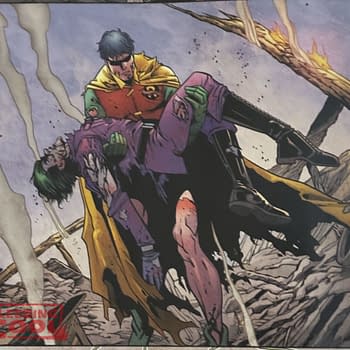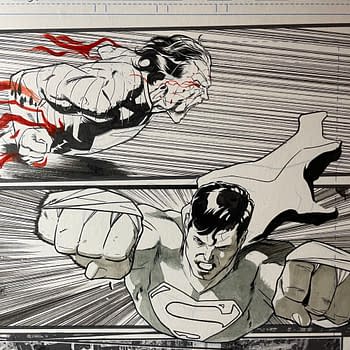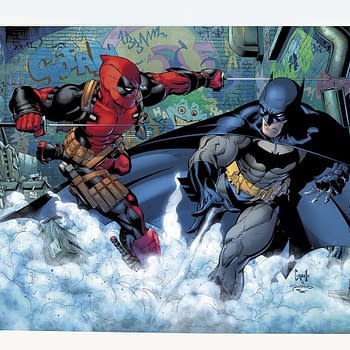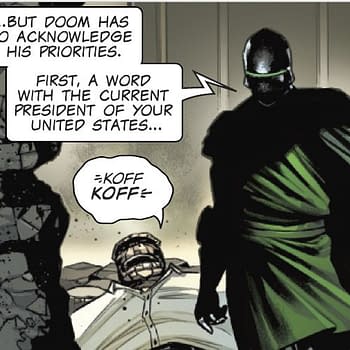Posted in: Comics, Heritage Sponsored, Vintage Paper | Tagged: Jack Kamen, Matt Baker, victor fox
Matt Baker & the Reinvention of Victor Fox, Jo-Jo Comics 25 at Auction
Within a few months in 1947, Matt Baker, Jack Kamen and the rest of the Iger Studio completely transformed Victor Fox's comic book line.
The business career of notorious comic book publisher Victor Fox often reads like a series of financial gambles driven by little more than his instincts. Fox was not a cautious man. He looked for ways to gain an edge, sometimes by pushing ethical boundaries, and when he found that edge, he pushed all his chips to the center of the table. When one hot streak ran out, he cut his losses and did it all over again. One example is Fox Feature Syndicate's operations after emerging from bankruptcy in early 1944. Fox had regained control of Blue Beetle, but the publisher was reentering a comic book field undergoing dramatic change. War-driven superhero titles were on the decline at most publishers. By 1946, Fox was seemingly desperate to try to save his prized Blue Beetle, while at the same time launching a range of children's humor and funny animal titles, like Jo-Jo Comics, Zoot Comics, and Wotalife Comics. By the war's end, Victor Fox had decided that Fox Feature Syndicate's return to glory would depend on funny animal mice, rabbits, and the like, but he soon discovered that he was betting on the wrong cat.
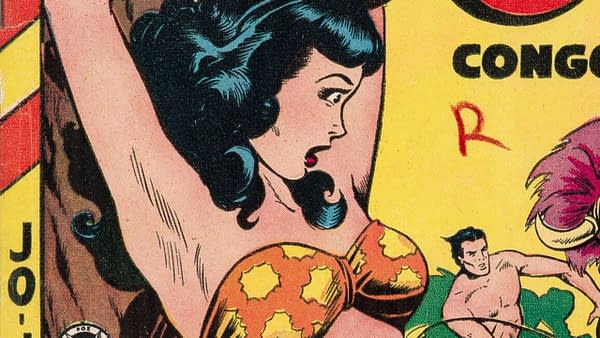
Fox's journey toward the company's Good Girl era can actually be traced to Blue Beetle. While some serious Golden Age fans realize that the title's Holyoke era is a radical departure from what came before, what happened after Fox got it back is arguably just as strange. As soon as Fox regained control of the title, Blue Beetle exhibited an unexplained Superman-style level-up in his abilities, seemingly in a bid to regain his stature as a superhero in a market that had seen dozens of them come and go by this time. His strength increased dramatically as he was regularly seen lifting cars and other heavy items. He began to seem invulnerable, easily breaking through brick walls and telling an opponent their bullets would be useless against him. Eventually, he even began to fly.
None of it worked. In August 1946, Blue Beetle (and Green Mask) were halted, and Fox's rising tide of funny animal and other humor titles completely took over the company. Such titles are all Fox Feature Syndicate published for the subsequent eight months. It would be interesting to know what impulse led Victor Fox down this path, without his usual brand of sneaking a look at DC's sales figures type of behavior that had gotten him this far in the comic book business. There were plenty of Disney, Terrytoons, and Looney Tunes titles on the stands every month by this time, and the likes of Cosmo Cat would seem to be a tough sell by comparison. Although being fair, that didn't stop other publishers from trying either.
Perhaps prompted by Samuel "Jerry" Iger, Fox began to put a new plan in motion with titles that hit newsstands in April 1947. Blue Beetle resumed with issue #45, touting itself as the "Return of America's No. 1 Hero," but with no apparent editorial changes — yet. More importantly, Zoot Comics #7 featured a radical change from kid's humor comic to Good Girl title, with the debut of Rulah, Jungle Goddess by Matt Baker in an interior story, and a Jack Kamen Rulah cover.
Within five months, Fox transformed a line entirely composed of children's humor comics into a line entirely composed of comics with racy Good Girl covers. Blue Beetle was de-emphasized on the covers of his own comic book in favor of beautiful women. Along with Zoot Comics, Jo-Jo Comics and All-Top Comics were likewise converted to jungle adventures. Most importantly, Phantom Lady was introduced to the Fox Feature Syndicate line-up. The character had been created at Eisner & Iger studio and published in Quality Comics' Police Comics from 1941-1943.
Bringing Phantom Lady to Fox Feature Syndicate, along with the other rather abrupt transformations at the publisher during this period, suggests that Iger sold Victor Fox on the notion that Good Girl art was the immediate future of comics and that artists like Baker and Kamen among others would enable that future. Fox transformed funny animal title Wotalife Comics into Phantom Lady with issue #13, where it would eventually become one of the most notorious comic book titles in American history. While many other publishers were edging into Good Girl art territory, Victor Fox was willing to bet his company on the trend.
Just as crucially, Matt Baker and Jack Kamen were not getting cover assignments at Fiction House (although Kamen eventually did in 1949). Matt Baker, Jack Kamen, and other Iger Studio artists completely reinvented the Fox Feature Syndicate line over the course of a few months in 1947. The cover of Jo-Jo Comics #25 is an iconic example of that reinvention, and there's a Jo-Jo Comics #25 (Fox Features Syndicate, 1949) CGC FN+ 6.5 White pages up for auction in the 2023 August 17 The Matt Baker Comics & Comic Art Showcase Auction #40233 at Heritage Auctions.











